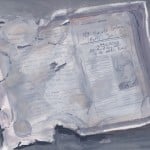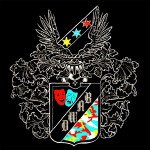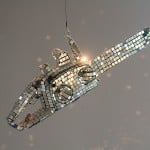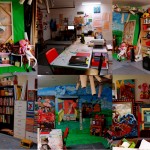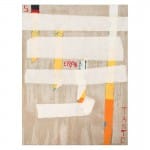- Julia Brown, Theory (Mâché), 2013, gouache on paper, 9 x 12 inches
- Phillip Pyle, II, D.W.A.B. Crest, rendering for site-specific mural
- The Art Guys, Saint Simon the Apostle (Party World), 2006, chain saw, mirror squares, motor, and lights, dimensions variable
- JooYoung Choi’s studio
- Oscar Rene Cornejo, 5, Eran Tanto: Seran Tanto, 2012, handmade paper on cement, acrylic, pigment, and animal fat on canvas, 18 x 24 inches.
A Group Exhibition Featuring Members of the DiverseWorks Artist Board
The DiverseWorks Artist Board provides integral programmatic input and helps to develop policies around the artistic direction of the organization. The Artist Board was purposefully created at the founding of the organization to ensure that artists remain central to DiverseWorks mission.
This exhibition takes its title from the word that designates a group of owls. Species of animals travel in various groups: a dazzle of zebras, a murder of crows, a pod of whales, a tower of giraffes, or a parliament of owls. During the middle ages, owls were often symbols of ominous forces and dark magic, while today they are typically associated with wisdom. Although these two concepts may seem contradictory, they both relate to the artistic process, which requires a combination of cognitive and intuitive skills. Creativity may be defined as the act of conjuring imaginative ideas into reality in order to reveal underlying truths and patterns related to the human condition.
Describing a group of owls as a parliament presents the idea of a democratically elected governing body. As an artist-centered institution, DiverseWorks believes it is essential for artists to have a stake in its programs so they are as relevant and beneficial as possible. This is a unique feature of DiverseWorks. What these artists do in the studio—their multi-faceted activities and practices—informs their participation on the Artist Board, and in turn, the programs at DiverseWorks. Together these artists contribute to an ecosystem and conversation that is vital for DiverseWorks and for Houston.
Parliament of Owls includes paintings, sculptures, photographs, mixed-media, videos, performances, and site-specific interventions in the gallery.
Artists
Daniel Adame is trained as a sculptor and a dancer. He makes work with his body and objects, typically involving points of struggle with architectural or spatial restrictions.
Michael Galbreth is a member of the artist duo The Art Guys with fellow artist Jack Massing. The Art Guys, whose prolific career began in the 1980s, create works that have a keen sense of humor, and convey some of the conceptual frustrations about art making. Their work involves materials as objects and generators of messages.
Julia Brown is a translator and instigator. Her work takes historical situations, current events, and found images that capture the underlying politics within everyday life, and reimagines them as paintings, photographs, moving images, or specific installations.
JooYoung Choi’s work stems from a deeply personal narrative known as the “Cosmic Womb.” Choi creates an imaginary landscape with puppets, paintings, and videos in which the artist is both a hyper real performer and a fantastical character.
Oscar Rene Cornejo’s artwork deals with the history of Latin America—with a particular emphasis on the El Salvador civil war (1980-1992)—and its effects on contemporary society. Through formal aesthetic technics Cornejo links this complicated historical narrative to a series of synthetic and organic materials used in his paintings, fabric works, and mixed media objects.
Sandy Ewen creates sound performances and visual works that explore texture, composition, and materials. Ewen is an avid experimenter. Mixing and mashing materials, sounds, and images together, she create a mysterious aura around her colorful compositions.
Mario E. Figueroa, Jr. aka GONZO247, is a teacher and self-taught Houston artist whose roots in the graffiti community date back to 1985. Gonzo’s work concerns itself with themes of social action, poverty alleviation, arts and culture, civil rights, and politics.
Mark Hirsch is a self-proclaimed InterArtist whose work uses experimental technology to reveal the impersonal aesthetics of digital technology. Hirsch strives to foster a greater awareness of self, space, and time through the creation of his environments.
Robert Hodge is an interdisciplinary artist whose practice takes the form of paintings, sculptures, musical recordings, and social practice interventions. Hodge references the particulars of Houston African American culture and history through a variety of visual and social practice techniques.
Loli Fernandez-Andrade Kolber’s work focuses primarily on drawing and mark making. She connects these humble materials and techniques to the history of mark making and stories of ancient cultures.
Rosine Kouamen was born in Cameroon and immigrated to the United States as a teenager. Her multimedia work investigates collective memory in cultures in which people have been displaced, and she investigates the mutations or cultural transformations that occur through immigration.
Jim Nolan is known for creating seemingly off-handed sculptures and installations made of quotidian materials and objects procured at Home Depot or the 99 Cent Store. Nolan’s works marry a formalist impulse with an overt love for material kitsch and a punk rock spirit.
Rebecca Novak has cross-disciplinary interests in visual art, social sculpture, and improvisational music. Novak works to combine each discipline by highlighting each individual technique through performative collaborations and installations.
Phillip Pyle, II is an image-maker whose practice focuses on the misunderstandings of racial stereotypes, neighborhood politics, sports, and popular culture. A former comedian, Pyle uses dark humor and appropriation to convey his ideas about the complexities of living in the Third Ward.
Stephanie Saint Sanchez, aka DJ ESTEFF, is an independent filmmaker whose work is influenced by her Humble Texas childhood, superstition, and mythology. Sanchez is a by-any-means-necessary artist who is motivated by fear, jealousy, and an interest in retelling the Latina female condition.
jhon r stronks’s performative works create various characters that attempt to reconcile childhood shame and guilt. stronks teaches dance performance and choreography, focusing on the conceptual importance invoked by embodied movement and personal expression.
Lillian Warren explores in-between situations and conditions, such as waiting rooms, airports, and the dislocation of human interaction that exist in that setting. Her ‘wait-scape’ paintings are created from digital photographs, which capture people forced to wait in various settings. She isolates each figure in a void or combines them into an alternate backdrop of repetition.
Tek Wilson is a theater artist. Her work as a performer, writer, and director explores domestic dramas filled with trauma and confusion. She often performs or directs characters that have recently experienced life-changing events or who are involved in seemingly banal domestic situations during which psychological conflicts arise.

